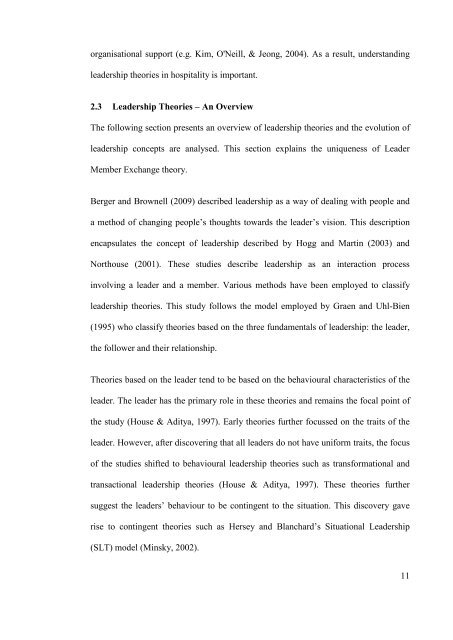View/Open
View/Open
View/Open
Create successful ePaper yourself
Turn your PDF publications into a flip-book with our unique Google optimized e-Paper software.
organisational support (e.g. Kim, O'Neill, & Jeong, 2004). As a result, understanding<br />
leadership theories in hospitality is important.<br />
2.3 Leadership Theories – An Overview<br />
The following section presents an overview of leadership theories and the evolution of<br />
leadership concepts are analysed. This section explains the uniqueness of Leader<br />
Member Exchange theory.<br />
Berger and Brownell (2009) described leadership as a way of dealing with people and<br />
a method of changing people’s thoughts towards the leader’s vision. This description<br />
encapsulates the concept of leadership described by Hogg and Martin (2003) and<br />
Northouse (2001). These studies describe leadership as an interaction process<br />
involving a leader and a member. Various methods have been employed to classify<br />
leadership theories. This study follows the model employed by Graen and Uhl-Bien<br />
(1995) who classify theories based on the three fundamentals of leadership: the leader,<br />
the follower and their relationship.<br />
Theories based on the leader tend to be based on the behavioural characteristics of the<br />
leader. The leader has the primary role in these theories and remains the focal point of<br />
the study (House & Aditya, 1997). Early theories further focussed on the traits of the<br />
leader. However, after discovering that all leaders do not have uniform traits, the focus<br />
of the studies shifted to behavioural leadership theories such as transformational and<br />
transactional leadership theories (House & Aditya, 1997). These theories further<br />
suggest the leaders’ behaviour to be contingent to the situation. This discovery gave<br />
rise to contingent theories such as Hersey and Blanchard’s Situational Leadership<br />
(SLT) model (Minsky, 2002).<br />
11

















